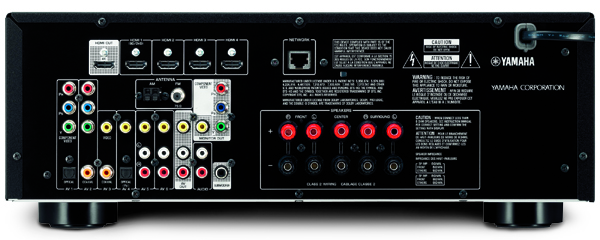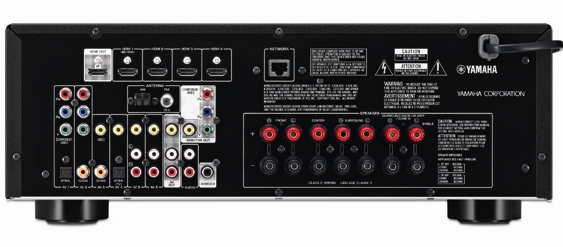Don't forget if you are powering a set of tower speakers the 573 can bi-amp. This would make a big difference for stereo listening.
Yamaha RX-V473 and RX-V573 A/V Receivers

Conventional wisdom amongst us A/V geeks who put audio performance above all else is that there’s no such thing as a good $500 A/V receiver anymore. At least not from the big, well-known manufacturers whose wares you’d find at the typical electronics store. This mythical beast did exist before the dark days, before the Features Wars, but given that even a mid-priced offering these days is expected to sport all sorts of streaming audio and video goodies, something had to give. And sound quality has traditionally been that something.
So it’s something of a novelty for me to be sitting here with not one, but two good $500-ish receivers from Yamaha. The company’s RX-V473 and RX-V573 look identical from the front and both fall within $50 of that target price point—the former fifty bucks down, the latter fifty bucks up.
Rather than dedicating two separate reviews to these receivers, we decided to put them head to head in one write-up. In this case, it makes sense, because, aside from the number of amplified channels delivered by each, the RX-V473 and RX-V573 are virtually the same receiver. Same remote. Same instruction manual. Same quick-start guide. Same setup menus. Same features set. Same dimensions. The only appreciable difference—aside from two-tenths of a pound of weight—is that the RX-V473 is a 5.1-channel model, whereas the RX-V573 adds two extra channels that can be configured as back surround channels, powered second-zone channels, or as biamplification for the front mains. Unfortunately, they cannot be configured as front presence speakers, and that’s a shame, since it’s a feature I’ve adored in Yamaha receivers in the past. To that, I say boo. But hey, again, for $500 (ish), you can’t expect to have it all.

Features
In terms of extra features, when talking about receivers at this price level that don’t suck right out loud in terms of audio performance, it’s reasonable to dial that “can’t expect to have it all” down to a “can’t expect much of anything.” The RX-V473 and RX-V573 do feature AirPlay support and “Made for” iDevice connectivity via their front-panel USB ports, as well as some rudimentary DLNA network connectivity and iOS/Android control app capabilities. AirPlay is definitely the feature I’ve gotten the most use out of. The only downside to Yamaha’s AirPlay implementation on these models is that you can’t use AirPlay itself to power on the receivers. That was definitely a neat trick with the Denon AVR-1913 I recently reviewed. The reason it’s not available here is because both of these receivers draw a minuscule 0.1 watt in standby mode—just enough to keep the IR receiver warmed up, but not enough to keep the device’s network connected and sniffing around for IP packets. So good-bye, vampire power! But also good-bye to a weensy bit of convenience.
As you may have figured out already this also means you can’t use the iOS/Android control apps to turn on the receivers. On paper, that sounds like a mighty major inconvenience; in practice, though, I found the app itself to be so cumbersome that it didn’t matter. It’s really nice for quick, direct access to some of the receivers’ tweaky features that you might play with once or twice, but that’s about it. The control app for Yamaha’s high-end Aventage line is, unsurprisingly, much better in my opinion.
The included hard-button remote for these receivers (identical except the RX-V573 remote has buttons for Zone A and B) isn’t anything to write home about, either. It’s crowded and confusing, and poorly laid out with a navigation pad that blends right in with the rest of the itty-bitty buttons. And no backlighting, to boot.
The remote does include a Yamaha staple I’ve enjoyed on past receivers from the company: “Scenes” buttons, which are normally very handy because they let you use the same input for multiple activities. With only four HDMI inputs (and two component video ins), though, and with two of the Scenes dedicated to broadcast radio and the RX-V473 and RX-V573’s limited network streaming and Internet radio capabilities, the Scenes implementation is way less useful here.
About right now, I would imagine you’re thinking to yourself, I thought he said these receivers were good for the money! They are! I promise. And we’ll get to that.
But first, one more itty-bitty sore spot.
Setup
If it’s been a few years since you’ve bought and set up a new AVR, the state of modern graphic user interfaces would probably shock you. In an incredibly short amount of time, we’ve gone from GUIs that look like MS-DOS’ overachieving little brother to full-blown setup wizards that even show you, with pictures and graphics, what to connect where and when.
And then there’s the Yamaha RX-V473 and RX-V573, whose setup screens would have been blah five years ago. No wizards. No navigational help. No graphics or images. Folks, welcome back to DOS-land.
That said, I found the menus really easy to navigate, and if this isn’t your first receiver, you might appreciate the simplicity and straightforwardness of the GUI experience here. Unless you want to rename inputs (which Yamaha makes really easy), there isn’t really much you need to do here, to be honest. You’ll probably want to use the Yamaha Parametric Room Acoustic Optimizer (YPAO) to set up your speakers instead of doing it manually, which means plugging the included microphone into the front of the receiver, pressing a button, waiting a few minutes, and pressing that button again.
YPAO only uses one listening position, instead of the five or six we find in some other room correction systems from Audyssey and Anthem. I have to say, though: I really like the results of YPAO for a receiver at this price point. It’s not as effective as the highly regarded Anthem Room Correction (ARC) solution in my reference prepro, but it’s certainly better than what I’ve experienced with the level of Audyssey room correction you’d get at this price (which would be plain-Jane MultEQ, not the more sophisticated MultEQ XT or XT32).
I should report, though, that running YPAO on the RX-V473 and the RX-V573 did give me pretty strikingly (and consistently) different results that initially resulted in pretty significant differences in sound quality—especially in the bass department. Both also wanted to set my crossover to 80 hertz, which is way too low for the Polk Audio Blackstone TL3 satellites I used for this review.


- Log in or register to post comments


How and i mean how is this a good deal? This is 350$ and their is pioneer receivers and even other Yamaha receivers with more power it can't even be loaded at 7 channels continuously.
This is just sad and its even more sad you guys gave it a 4.5 on the charts(audio) i used to come her every single day reading not replying but this by all means is sad its weaker then Pioneer 521-K for just 200$.
Not even good enough for most satellite systems.
This should be a quad only company at least their mediocre at that.
And you guys should be ashamed.


Nice Review. AVR good for high sensitivity speakers.

Very accurate review of the AVRs.
Note also that the RX-V473 is also the HTR-4065, which was sold at Costco and later, other stores.
“The only downside to Yamaha’s AirPlay implementation on these models is that you can’t use AirPlay itself to power on the receivers.”
There is Network Standby on these AVRs. See page 78 of manual. It “Selects whether the unit can be turned on from other network devices.” It consumes 2 W of power.
I’ve not been able to get it to work (turn on AVR when selected to play from iTunes) but, the Yamaha YWA-10BL Wireless Network Adapter is on and showing the AVR on the Airplay menu in iTunes. I suspect, because it is a disordered manual and inflexible interface, I just have something set wrong. (The setup, manual, UI, and complexity - the whole ball of wax with this unit - is what *bad* user experience design is.)
It is a hard unit to set up. On that alone, I would recommend a more expensive Yamaha or an AVR known for ease of set up and ease of use and well designed interface with decent typography.
For the technically adept, very patient, bargain hunter, it is as described in the review. Now that it is no longer made, it is also way cheaper. I see the 473 for $300 now, new. The YWA-10BL is also $50 now.

Yamaha receivers have always been good, no question asked. I have the YWA-10bl and i`m happy with it.





































































